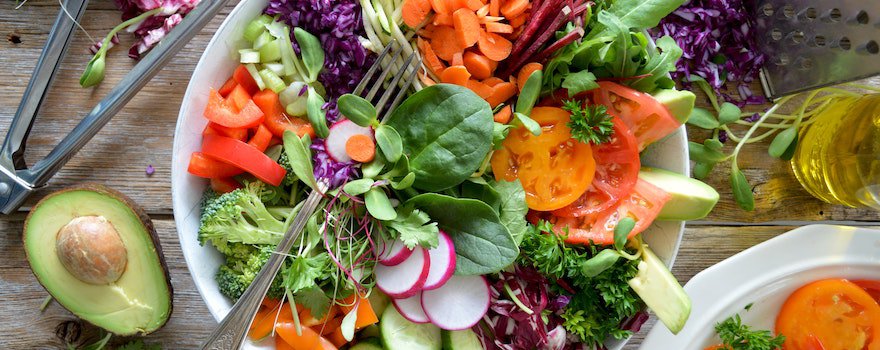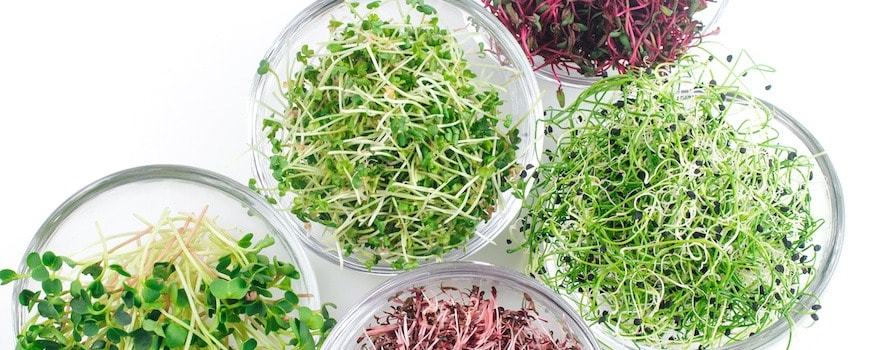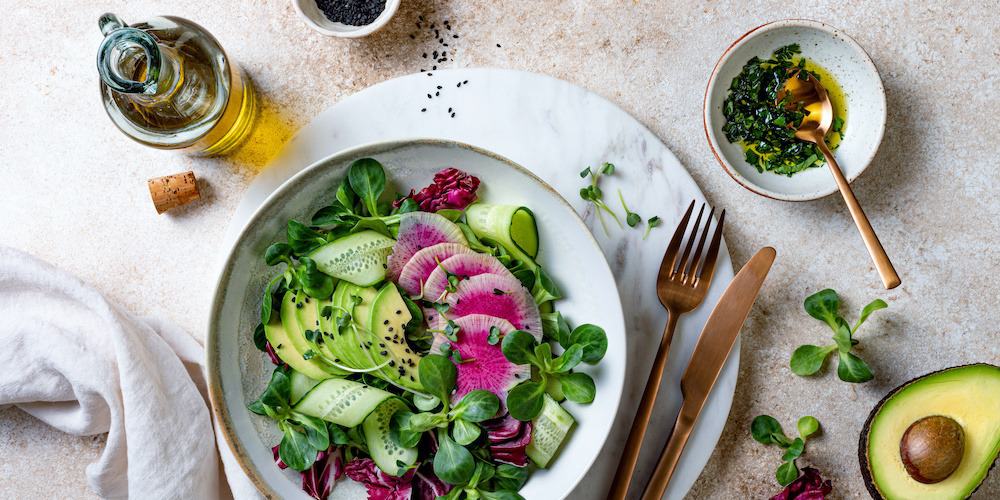There is no strict definition of the living diet. It refers to the consumption of natural, raw products. And it emphasizes foods that come from the plant kingdom.
This type of diet excludes processing methods such as the refining of sugar or grains, the roasting of coffee, and the pasteurization of cream or fruit juice.
The main foods that are part of the living diet are fruits, vegetables, seaweeds, seeds, oilseeds (nuts), and fermented foods.
Living food is often contrasted with ultra-processed products and junk food that provide “empty calories” to the body. These products have very low nutritional quality (vitamins, minerals, etc.).
Here are the foods to include on your plate to get started or continue consuming products of the living diet. See after the list to learn more about this type of diet.
1. Fresh fruits and vegetables

The emphasis is on fresh, seasonal, and organic fruits and vegetables. Alternate the colors of vegetables on the plate to vary micronutrient intake.
For example, spinach is rich in vitamin K and iron. Carrots are rich in vitamin A and vitamin C. In summer, you can eat red berries that are high in antioxidants.
How to consume them: eat them as soon as possible after harvest or after purchase to reap their benefits. A juice extractor helps preserve their vitamins and minerals as much as possible. Gentle, low-temperature cooking methods like steaming are recommended. You can choose dried fruits such as dates or apricots.
2. Seeds and dried fruits

There is a wide array of seeds and oilseeds!
- Chia seeds contain a lot of fiber.
- The flax seeds are rich in essential fatty acids, just like the hemp seeds.
- The Brazil nuts are rich in selenium.
- Hazelnuts are a source of fiber and vitamin E.
How to consume them: you can include sunflower seeds, sesame, pine nuts, walnuts, almonds, and pistachios in many dishes! Pistachios pair very well with red berries such as strawberries. Meanwhile, pumpkin and sunflower seeds can be easily sprinkled on salads.
3. Seaweeds

There are no fewer than 800 varieties of seaweed in France! They have undeniable nutritional benefits. They provide notable amounts of vitamins, minerals, and fiber.
The wakame is very rich in proteins. The nori is also rich in plant proteins and a good source of vitamin B12.
How to eat them: You can rehydrate dried seaweed in water and season it to enjoy in a salad. Fresh seaweed is rinsed in water to remove excess salt before preparing. You can start with a small amount to get used to their iodine taste.
4. Sprouted seeds

It is possible to sprout cereal seeds like wheat or barley, as well as plants like alfalfa, or oilseeds.
As fresh as they are crunchy, they are packed with vitamins and minerals.
How to eat them: You can add them to a salad, to a warm or cold vegetable soup, or to a sandwich. It is possible to sprout them yourself while taking some precautions. Otherwise, you can buy them in most health food stores.
5. Lacto-fermented foods

Lacto-fermentation is an ancient method of consuming foods. It helps boost the nutritional quality of foods by increasing the number of lactic bacteria in foods.
By consuming them, we ingest probiotics, the beneficial bacteria for our gut flora.
Listen to our podcast | The secrets of fermentation
How to consume them : the sauerkraut is the quintessential lacto-fermented vegetable. But you can also lacto-ferment carrots or cucumbers, for example. Milk or fruit kefir is a fermented beverage that boosts the gut microbiota. Rejuvelac is a fermented beverage made from sprouted grains.
Also read Our probiotic buying guide
Living diet: what are its advantages and disadvantages?
Living foods should be incorporated as part of a diversified and varied diet.
This is not about consuming only raw foods (raw foodism). This type of diet can lead to deficiencies and foodborne illnesses.
On the PNNS (National Nutrition and Health Program) website, you can find nutrition recommendations.
The consumption of fruits and vegetables is encouraged, whether raw or cooked. But dried legumes are also recommended due to their fiber content. As are starchy foods.
Raw fruits and vegetables generally contain more vitamins, minerals and trace elements than their cooked counterparts.
For example, the amount of vitamin C is lower in raw broccoli than cooked, as highlighted by this study.
However, there are exceptions. This study showed that the amount of lycopene (an antioxidant compound) was higher in heat-treated tomatoes than in raw ones.
Cooking has a sanitizing role because it eliminates bacteria from food.
Finally, we are not all equal when it comes to digesting raw fruits and vegetables, and cooking them can make their fibers easier to digest.
Limiting consumption of ultra-processed, low-nutrient products is one of the benefits of favoring living foods.
Another recommendation is to reduce white sugar consumption and favor alternatives like honey.
For oils, consider organic oils that are first cold-pressed.
In conclusion, make sure to balance your diet to avoid deficiencies and to meet public health recommendations. Adopt a diversified diet by including “living foods” on your plate.



